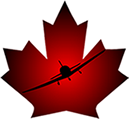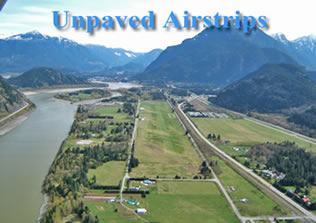 |
|
Unpaved Airstrips"Oft on the dappled turf at ease --William Wordsworth-- As the weather begins to improve, thoughts of heading out to some little, unimproved airstrip tend to bubble up in a pilot’s mind. There’s just something about the good weather that tends to reinforce the urge to explore. Many small grass and gravel aerodromes are particularly inviting this time of year. The picture isn’t all that difficult to live with: warmth, soft grass, a nice picnic lunch… maybe even a bit of fishing or just a nice walk along a stream. Before tackling those delightful little aerodromes, it is an excellent plan to remember that and aerodrome with an unpaved surface is essentially different from a paved surface runway. In many ways, dealing with an unpaved runway is more akin to dealing with a living thing than a static, unchanging man-made artifact. Turf or grass, particularly, is a variable, ever-changing commodity with moods and peculiarities. It serves us well to understand those moods if we are to maintain a safe and productive relationship. The surface of a turf or grass landing aerodrome changes constantly with temperature, humidity, precipitation, amount of use, and level of maintenance. The same little aerodrome will present a very different surface on different days and can give an unsuspecting pilot a serious surprise if he or she isn’t prepared and paying attention. Gravel surface runways respond to the same factors although in a slightly less dynamic manner. In general, if we take a look in our aircraft’s POH, we note there is a penalty for landing or taking off on a dry grass surface: something in the neighbourhood of 20%. If it has rained recently or if the fellow who normally mows the field has taken a couple of weeks off, that penalty can be significantly higher. Wet or long grass will produce considerably more resistance to our efforts to move the aircraft through it than dry, short grass. Standing water and puddles can create significant difficulties. Gopher or groundhog holes can end a flight very quickly or result in serious damage to your landing gear. Temperature can influence our grass field in a number of ways. Hot weather tends to dry out the underlying soil and produce a harder surface. If the landing area is used on a regular basis, the surface will tend to develop "wash-boarding" similar to what you might observe on a beach or the bottom of a sandy creek. The action of wheels rolling on a surface composed of particles produces this wash-boarding effect. Taxiing an aircraft over a wash-boarded surface can be very hard on the machinery, not to mention the pilot and passengers. Back in the bad old days, when an aircraft’s third wheel was bolted to the backend, propeller clearance during taxi was not normally a big problem. Visibility, on the other hand, often was. Now, most people operate tricycle gear aircraft and visibility is generally quite good; however, it is very important when taxiing on a rough surface to both protect the vulnerable nose gear and ensure that propeller clearance is maintained. When taxiing a tricycle gear aircraft on a rough surface, it’s always a good plan to hold the elevators in full up position and taxi slowly particularly in wash-board conditions that can set you up for a cyclic bouncing motion ending in big difficulties. Pilots of conventional gear aircraft will also normally want elevators in an up position but may ease them slightly to reduce down-force from the prop wash so weight taken by the tail wheel is not excessive. Slow taxi is also important and ‘S’ turning may be necessary to ensure proper visual scanning of ground conditions and potential obstacles. A log or hole hidden by long grass can be a serious problem. Freezing temperatures also produce a very hard surface. Very difficult conditions can result right after a freeze followed by a thaw. The ground can frost-heave and produce a muddy, disturbed surface on which it will be very difficult to manoeuvre. Generally, a quite compelling reason is necessary before making use of grass or gravel strips with high dirt content during these difficult times of the year when they are muddy and unreliable. Rain can reduce a delightful, little field into a muddy quagmire. Getting an aircraft stuck in the mud is not a particularly enjoyable experience. I can speak from personal experience. If the aircraft is small and light enough, and there are enough spare and willing helpers handy, it’s no more than a case of swallowing some pride and asking for help to pull the machine free. If it’s a larger aircraft, getting stuck in the mud can result in a bigger adventure than you might have chosen. Clean, packed gravel is less vulnerable to frost-heave or the effects of rain than a grass or turf landing area. Gravel which has a high dirt content or a packed earth landing surface, however, can have all the potential for difficulties found with grass or turf. Performing a run-up on a grass or gravel surface presents its own set of opportunities for trouble. Pick your run-up spot with care and attention. You may or may not have an appropriate area available for a power run-up. We don’t want to run the engine at a high rpm and risk damage to the propeller or the airframe from flying debris. If you do increase rpm, do it slowly to reduce the risks involved. You may not want to open carburetor heat on the ground at all unless absolutely necessary. Avoiding unfiltered air and the debris it may carry from being sucked into the engine is an excellent plan. Loose grass clippings, dust, gravel particles: all very bad news for the insides of your engine. If you’re the first guy out of an unpaved strip in the morning, before you even untie the machine it’s an excellent plan to do a nice, relaxed inspection walk down the field. This reduces surprises considerably. Just because you flew in yesterday or a few days before doesn’t mean you can fly out today. If you are coming in for a landing, particularly at a strip that has had little traffic, consider making use of the precautionary landing technique. Make an initial high pass to scope out the situation, check on the wind, landmarks, obstacles and any other pertinent information: get a good overview. Follow that with a nice, slow, low pass so you can get a really good look at the condition of the strip before you decide to risk putting your valuable and expensive wheels on it. Sometimes, more than one pass is called for to make certain everything is looking good. Making use of unimproved airstrips will increase the number of interesting destinations available during these months of delightful weather. Making sure before you set out that you are current and comfortable with the necessary procedures and techniques and are aware of the peculiarities of grass and gravel aerodromes and landing surfaces can help reduce risks and ensure you will enjoy your adventures. |



